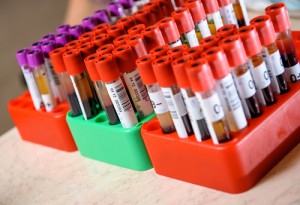Guidance & Diagnostic: New Patent Eligibility Examples
 {3:35 minutes to read} On May 5, 2016, the USPTO published new patent eligibility examples, including two examples related to diagnostic methods (examples 29 and 31).
{3:35 minutes to read} On May 5, 2016, the USPTO published new patent eligibility examples, including two examples related to diagnostic methods (examples 29 and 31).
Example 29 is directed to a method for diagnosing and treating Julitis (a hypothetical disease).
According to the hypothetical, Julitis is an autoimmune disease causing chronic inflammation of the skin. Julitis is conventionally diagnosed by a physical examination of the skin, which shows a rash. This rash appears to be similar to rashes caused by rosacea, and therefore, Julitis is often misdiagnosed.
Applicant has discovered that the patients with Julitis have a protein “JUL-1” in the body (plasma, skin, hair and nails). On the contrary, this protein is not found in people not affected by Julitis (but for example affected by rosacea). The JUL-1 protein could be discovered (with conventional methods) using naturally occurring antibodies or non-naturally occurring antibodies created by the applicant (a pig-derived recombinant anti-JUL-1 and an antibody called mAb-D33).
The applicant has also discovered that Julitis is treatable with vitamin D (which was never before used to treat Julitis).
Of the claims listed, claims 1 and 7 are considered eligible because they are not directed to a judicial exception. Claim 2 is considered ineligible, as being directed to a judicial exception and the additional elements do not amount to significantly more. Claims 3-6 are directed to a judicial exceptions but are eligible because they recite specific and unconventional reagents and/or treatments that amount to significantly more than the exception.
The claims are as follows:
1. A method of detecting JUL-1 in a patient, said method comprising:
a. obtaining a plasma sample from a human patient; and
b. detecting whether JUL-1 is present in the plasma sample by contacting the plasma sample with an anti-JUL-1 antibody and detecting binding between JUL-1 and the antibody.
2. A method of diagnosing Julitis in a patient, said method comprising:
a. obtaining a plasma sample from a human patient;
b. detecting whether JUL-1 is present in the plasma sample by contacting the plasma sample with an anti-JUL-1 antibody and detecting binding between JUL-1 and the antibody; and
c. diagnosing the patient with Julitis when the presence of JUL-1 in the plasma sample is detected.
3. A method of diagnosing Julitis in a patient, said method comprising:
a. obtaining a plasma sample from a human patient;
b. detecting whether JUL-1 is present in the plasma sample by contacting the plasma sample with a porcine anti-JUL-1 antibody and detecting binding between JUL-1 and the porcine antibody; and
c. diagnosing the patient with Julitis when the presence of JUL-1 in the plasma sample is detected.
4. A method of diagnosing Julitis in a patient, said method comprising:
a. obtaining a plasma sample from a human patient;
b. detecting whether JUL-1 is present in the plasma sample by contacting the plasma sample with antibody mAB-D33 and detecting binding between Jul 1 and antibody mAb-D33; and
c diagnosing the patient with Julitis when the presence of Jul-1 in the plasma sample is detected.
5. A method of diagnosing and treating Julitis in a patient, said method comprising:
a. obtaining a plasma sample from a human patient;
b. detecting whether JUL-1 is present in the plasma sample;
c. diagnosing the patient with Julitis when the presence of JUL-1 in the plasma sample is detected; and
d. administering an effective amount of topical vitamin D to the diagnosed patient.
6. A method of diagnosing and treating Julitis in a patient, said method comprising:
a. obtaining a plasma sample from a human patient;
b. detecting whether JUL-1 is present in the plasma sample;
c. diagnosing the patient with Julitis when the presence of JUL-1 in the plasma sample is detected; and
d. administering an effective amount of anti-tumor necrosis factor (TNF) antibodies to the diagnosed patient.
7. A method of treating a patient with Julitis, the method comprising administering an effective amount of anti-TNF antibodies to a patient suffering from Julitis.
Contact me with questions or comments at silvia@salvadorilaw.com.

Silvia Salvadori, PhD
www.salvadorilaw.com
www.salvadorilaw.com/blog
silvia@salvadorilaw.com
(212) 897-1938
